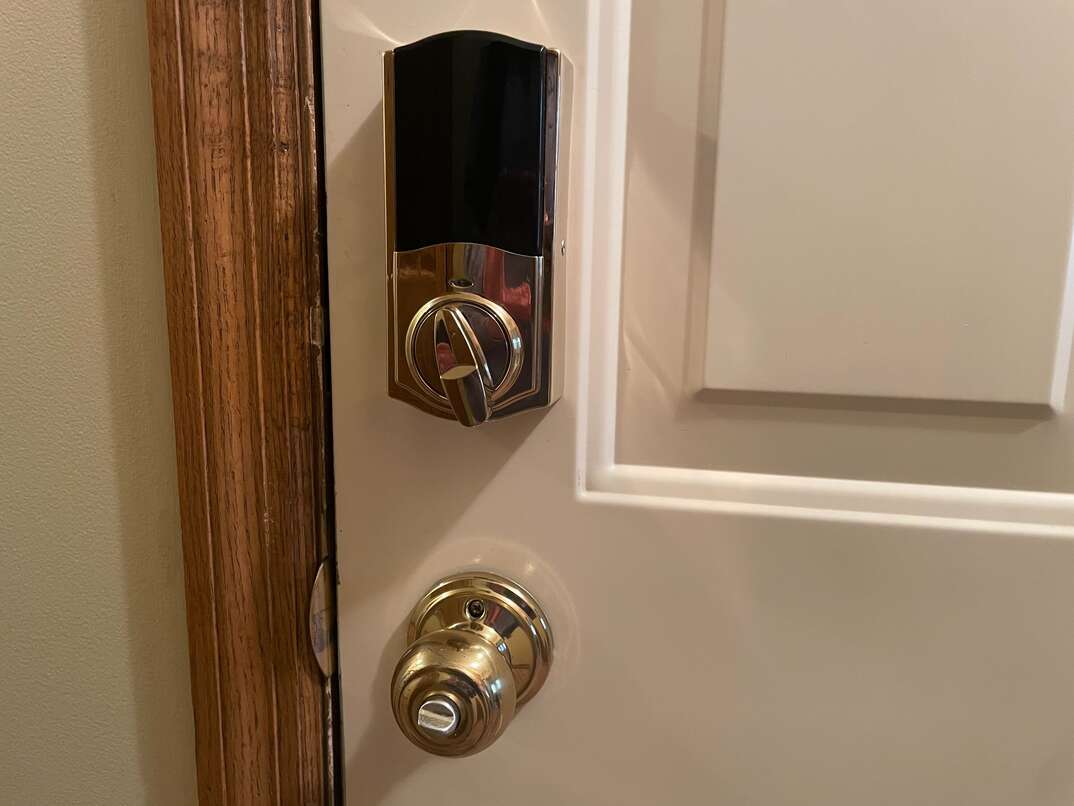How to Maintain Door Locks: 5 Key Steps

When was the last time you thought about the proper maintenance and care of your door locks? If you’re like the majority of homeowners, the answer is, well, probably not very recently. After all, once the door is shut and locked, the rest is out of sight, out of mind, right?
Even though lock maintenance isn’t something that’s on most homeowners’ to-do lists, it’s still a very important aspect of home upkeep. Maintaining your locks ensures their long-term performance, helping you save money on costly lock repairs and replacements in the future. Plus, a loose, wiggly or finicky lock is also less secure, posing an unnecessary risk for you and your family.
Lock Maintenance 101
To keep your locks operating in tip-top shape, here are five steps to work into your regular home maintenance routine:
Step 1: Make Sure Your Door Is Hung Properly
The first step to keeping your locks in good working order is to ensure your door is hung properly. Having a door that’s not hung correctly can put unnecessary pressure on the lock, creating lock issues (and even lock failure) over time.
To inspect the door, check to see that it isn’t sagging or drooping in any areas and that it’s completely even with the door frame. Try opening and shutting the door carefully. A properly hung door won’t bind or rub against the frame, and there won’t be any uneven gaps or spacing. If you still aren’t sure how to identify an incorrectly hung door, have a professional locksmith conduct an inspection for you.
Step 2: Inspect the Door’s Screws and Strike Plates
Another important way to make sure your locks stay in good condition is to inspect your door’s screws and strike plates to make sure they’re securely fastened to the wall framing. As a general rule, at least one screw in the top hinge should be long enough (typically 3 inches) to secure the door to the wall. That said, adding 3-inch screws to all the hinges will prevent your door from sagging, which keeps your door locks from doing all of the heavy lifting. While you’re at it, you’ll also want to add 3-inch screws to your strike plate to keep it extra secure.
Step 3: Check the Deadbolt
Along with making sure your hinges and strike plates are secure, you should also routinely inspect your deadbolt. An essential piece of door security, deadbolts need to be correctly aligned with the strike plate. If the deadbolt is performing as it should, you won’t need to pull or lift the door for it to slide into the deadbolt’s hole. If the deadbolt can’t move freely and easily extend into the hole, it poses a security risk.
More Related Articles:
- 8 Benefits of Installing Smart Locks
- Here’s How Much a Locksmith Charges for 5 of the Most Common Services
- Lose Your Keys Often? Here's How to Prevent Lockouts
- Installing a New Deadbolt? Here's Everything You Need to Know
- What Is Rekeying a Lock?
Step 4: Clean and Lubricate Your Locks
Another essential piece of door lock maintenance is cleaning and lubricating them every three to six months. Over time, dirt, debris and other particles and chemicals travel into the inner lock mechanisms, creating friction from inside the lock. As you can imagine, this can interfere with the lock working properly. Left alone, the lock might eventually quit working altogether.
Follow these steps to lubricate your locks:
- Start by using pressurized air to blow dust out of the keyway.
- Then, lubricate your lock with a graphite spray lock lubricant.
- Spray the lubricant into the keyhole, making sure there’s enough lubricant to reach deep into the lock mechanism.
- Then, slide a key in and out of the keyhole, and open and close the lock several times.
- Be sure to wipe any excess lubricant off the lock and let it air dry.
Step 5: Make Copies of Your Original Keys
Generally speaking, your keys will wear out long before your lock ever will, and when a key goes bad, it’s never a good thing for a lock. When the cuts on a key start to get worn down with age, it causes the pins and wafers in the locking mechanism to not line up properly, eventually preventing the cylinder from turning.
Because a bad key can cause problems for your lock, it’s important to always replace a key once it starts to wear out. However, you need to keep in mind that when copies are made of keys, they’re never exact replicas. So, if you make a copy of a worn-out key, or if you make a copy of a copy, you’re setting yourself up for lock issues in the near future. You can avoid all this trouble by keeping an original key and storing it in a safe and secure place. When the time comes to replace a key, use the original to make a duplicate. That way, you can ensure you’re getting the best possible copy made for your locks.
There are several steps you can take to keep your locks maintained. By doing so, you’ll keep repair costs down and keep your home (and those in it) safe and secure for years to come.
Elocal Editorial Content is for educational and entertainment purposes only. Editorial Content should not be used as a substitute for advice from a licensed professional in your state reviewing your issue. Systems, equipment, issues and circumstances vary. Follow the manufacturer's safety precautions. The opinions, beliefs and viewpoints expressed by the eLocal Editorial Team and other third-party content providers do not necessarily reflect the opinions, beliefs and viewpoints of eLocal or its affiliate companies. Use of the Blog is subject to the
Website Terms and Conditions.The eLocal Editorial Team operates independently of eLocal USA's marketing and sales decisions.

